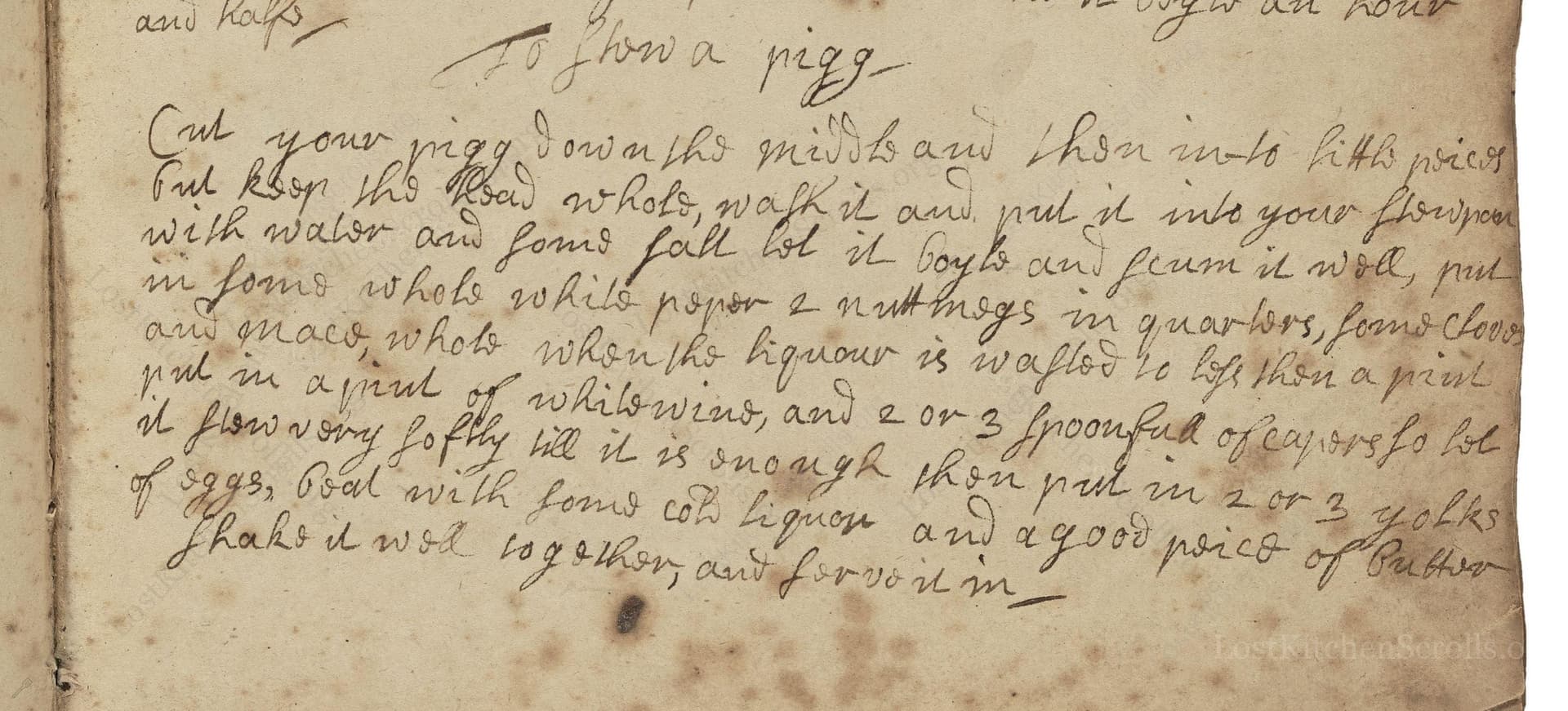To Stew A Pigg
From the treasured pages of Receipt book of Jane Staveley
Written by Jane Staveley

To Stew A Pigg
"Cut your pigg in small peices and skin into little peices Cut the head whole, wash it and put it into your stewpan with water and some salt, let it boyle and scum it well, put in some whole white peper & nuttmegs in quarters, some cloves and mace, whole when the liquor is wasted to less then a pint put in a pint of whitwine, and 2 or 3 spoonfuls of capers, so let it stew very softly till it is enough then put in 2 or 3 yolks of eggs, beat with some cold liquor and a good peice of butterr Shake it well together, and serve it in."
Note on the Original Text
The recipe, like many of its time, is presented in narrative form with scant punctuation and no precise measurements, relying on the cook's experience. Spelling variants like 'boyle' (boil), 'liquor' (cooking liquid), and 'scum' (skim off froth) reflect Early Modern English usage. Notably, instructions often blend ingredients and methods together, with the expectation that the cook is well-versed in basic culinary technique—hence the lack of detail on temperatures or cooking times.

Title
Receipt book of Jane Staveley (1693)
You can also click the book image above to peruse the original tome
Writer
Jane Staveley
Era
1693
Publisher
Unknown
Background
Step into the flavorful annals of the 17th century with Jane Staveley’s delightful culinary collection. Brimming with time-honored recipes and refined instructions, this book offers a sumptuous glimpse into the kitchens of yesteryear—where classic techniques met noble tastes and every dish was a celebration of ingenuity.
Kindly made available by
Folger Shakespeare Library
This recipe originates from the late 17th century, specifically from the collection of Jane Staveley dated 1693 to 1694—a period when English household cookery was undergoing fascinating shifts. Dishes like this represent the blending of medieval and early modern tastes: heavy use of spices, sweet and savory, and rich, luscious finishes with egg and butter. Pig, then as now, was a commonly butchered animal on English estates, and every part—including the head—would have been used. The inclusion of capers and imported white wine signals a certain level of affluence, suggesting this was a dish for comfortable gentry rather than the everyday laborer.

In the late 1600s, the stew would have been prepared over an open hearth, using heavy iron or copper stew pans suspended by hooks or set on the hearth trivet. Scumming was accomplished with large, flat-bowled spoons or ladles, and ingredients stirred with long wooden spoons. Egg yolks would be beaten with a wooden whisk or fork. Little pestles would crack spices, and serving involved wide, shallow bowls or trencher plates.
Prep Time
20 mins
Cook Time
3 hrs
Servings
6
We've done our best to adapt this historical recipe for modern kitchens, but some details may still need refinement. We warmly welcome feedback from fellow cooks and culinary historians — your insights support the entire community!
Ingredients
- 3 pounds pork shoulder or mixed pork cuts (optionally include pig's head or substitute with more fatty pork)
- 2 teaspoons salt
- 1 teaspoon whole white peppercorns
- 1 whole nutmeg, cracked into quarters
- 4-5 whole cloves
- 1 teaspoon whole mace (or 1/4 teaspoon ground mace as substitute)
- 1 cup dry white wine
- 2-3 tablespoons capers
- 2-3 egg yolks
- 3 1/2 tablespoons unsalted butter
Instructions
- Begin by selecting about 3 pounds of young pork (such as boned pork shoulder or a combination including pig's head, if available).
- Cut the pork into small pieces, leaving the head whole if using.
- Rinse all pieces thoroughly and place them in a large stew pot with enough water to cover, adding about 2 teaspoons of salt.
- Bring to a boil, skimming off any scum that rises.
- Once the scum is removed, add 1 teaspoon whole white peppercorns, 1 nutmeg cracked into quarters, 4-5 whole cloves, and 1 teaspoon whole mace.
- Let the stew simmer uncovered until the liquid reduces to less than 2 cups.
- At this point, pour in 1 cup of dry white wine and 2-3 tablespoons of capers.
- Continue simmering gently until the pork is tender.
- In a separate bowl, beat 2-3 egg yolks with a splash of cool broth from the pot.
- When the stew is finished, reduce the heat and stir the egg yolk mixture and 3 1/2 tablespoons of cold butter into the stew, shaking or stirring vigorously to thicken the sauce slightly.
- Adjust seasoning and serve immediately.
Estimated Calories
480 per serving
Cooking Estimates
It takes about 20 minutes to prepare the ingredients, then 2.5 to 3 hours to cook the pork until very tender and finish the sauce. This recipe serves about 6 people, and each serving is roughly 480 calories.
As noted above, we have made our best effort to translate and adapt this historical recipe for modern kitchens, taking into account ingredients nowadays, cooking techniques, measurements, and so on. However, historical recipes often contain assumptions that require interpretation.
We'd love for anyone to help improve these adaptations. Community contributions are highly welcome. If you have suggestions, corrections, or cooking tips based on your experience with this recipe, please share them below.
Join the Discussion
Rate This Recipe
Dietary Preference
Occasions

Den Bockfisch In Einer Fleisch Suppen Zu Kochen
This recipe hails from a German manuscript cookbook compiled in 1696, a time whe...

Die Grieß Nudlen Zumachen
This recipe comes from a rather mysterious manuscript cookbook, penned anonymous...

Ein Boudain
This recipe comes from an anonymous German-language manuscript cookbook from 169...

Ein Gesaltzen Citroni
This recipe, dating from 1696, comes from an extensive anonymous German cookbook...
Browse our complete collection of time-honored recipes



